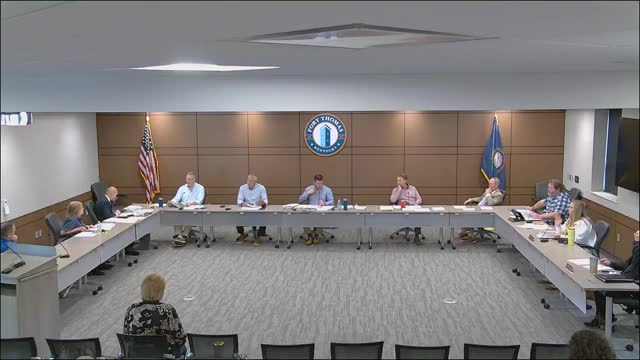Fort Thomas finance committee: first-quarter financials track to budget despite timing-driven variances
November 10, 2025 | Fort Thomas, Campbell County, Kentucky
This article was created by AI summarizing key points discussed. AI makes mistakes, so for full details and context, please refer to the video of the full meeting. Please report any errors so we can fix them. Report an error »

Fort Thomas finance staff presented the city's General Ledger Monthly Financial report for the first quarter (July'September) and told the finance committee that, on balance, the city is tracking near expected budget percentages but that several funds show large timing-driven variances.
The presenter said several one-time or seasonally timed items explain apparent over- and under-spending. Examples cited included an annual July 1 payment of major insurance premiums that skews departmental insurance line items; an escrow established at bond issuance that holds a separate cash account for at least one year's debt service; and a three-pay month in August that inflates salary and benefit percentages in the first quarter. The presenter noted the KDOT fund is higher now but will be drawn down by planned street projects that begin in spring, and that waste-fee receipts concentrate in October.
The committee and staff discussed the city's self-funded health insurance fund. Staff confirmed the health fund cash balance is included in fund balance on a fund-basis and therefore appears in government-wide net position; by contrast, the pension fiduciary fund is excluded from the government-wide net position. Staff said the health fund balance currently shown in the report is roughly $1,000,000 and recommended a carry target closer to $500,000–$600,000 for routine operating needs while retaining the ability to respond to catastrophic claims quickly (staff noted stop-loss reimbursement timing can require advance cash outlays). Council asked about the formal mechanics to move money between funds; staff reiterated that interfund transfers and any changes to restrictions are executed through the annual budget process or by ordinance and therefore require council action.
On departmental detail, staff said several accounts that appear high year-to-date have clear explanations: police overtime and early-year purchase of cruisers; a July 1 transfer into the debt service fund that temporarily increases that account's cash balance; and uniform and equipment purchases that typically occur at the start of the fiscal year. Staff described ongoing accounting changes intended to improve monthly comparability, including a change to allocate workers'comp and certain insurance costs monthly rather than by a year-end allocation.
Staff recommended continuing monthly reporting and said next month's statements should better reflect regular patterns after timing-driven spikes. Committee members asked staff to circulate additional detail behind line items that skewed percentages and to provide suggested budget amendments if warranted.
Next steps: staff will distribute monthly follow-up materials and refine allocation methodology for workers'comp and insurance so department-level comparisons are more consistent month-to-month.
The presenter said several one-time or seasonally timed items explain apparent over- and under-spending. Examples cited included an annual July 1 payment of major insurance premiums that skews departmental insurance line items; an escrow established at bond issuance that holds a separate cash account for at least one year's debt service; and a three-pay month in August that inflates salary and benefit percentages in the first quarter. The presenter noted the KDOT fund is higher now but will be drawn down by planned street projects that begin in spring, and that waste-fee receipts concentrate in October.
The committee and staff discussed the city's self-funded health insurance fund. Staff confirmed the health fund cash balance is included in fund balance on a fund-basis and therefore appears in government-wide net position; by contrast, the pension fiduciary fund is excluded from the government-wide net position. Staff said the health fund balance currently shown in the report is roughly $1,000,000 and recommended a carry target closer to $500,000–$600,000 for routine operating needs while retaining the ability to respond to catastrophic claims quickly (staff noted stop-loss reimbursement timing can require advance cash outlays). Council asked about the formal mechanics to move money between funds; staff reiterated that interfund transfers and any changes to restrictions are executed through the annual budget process or by ordinance and therefore require council action.
On departmental detail, staff said several accounts that appear high year-to-date have clear explanations: police overtime and early-year purchase of cruisers; a July 1 transfer into the debt service fund that temporarily increases that account's cash balance; and uniform and equipment purchases that typically occur at the start of the fiscal year. Staff described ongoing accounting changes intended to improve monthly comparability, including a change to allocate workers'comp and certain insurance costs monthly rather than by a year-end allocation.
Staff recommended continuing monthly reporting and said next month's statements should better reflect regular patterns after timing-driven spikes. Committee members asked staff to circulate additional detail behind line items that skewed percentages and to provide suggested budget amendments if warranted.
Next steps: staff will distribute monthly follow-up materials and refine allocation methodology for workers'comp and insurance so department-level comparisons are more consistent month-to-month.
View the Full Meeting & All Its Details
This article offers just a summary. Unlock complete video, transcripts, and insights as a Founder Member.
✓
Watch full, unedited meeting videos
✓
Search every word spoken in unlimited transcripts
✓
AI summaries & real-time alerts (all government levels)
✓
Permanent access to expanding government content
30-day money-back guarantee

